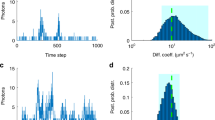Abstract
Fluorescence correlation spectroscopy (FCS) is a relatively recent technique in which the diffusion coefficient of fluorescently labeled molecules can be determined. The change in diffusion behavior when these molecules interact with others can also be used to study interactions in solution. A new statistical method is proposed to analyze FCS measurements that cannot be evaluated with a classical autocorrelation function, which is normally used to analyze FCS data. It applies to binding studies where one of the interacting particles has a much brighter fluorescence intensity with respect to the other, which causes high fluorescence bursts whenever these molecules are detected. This biases the autocorrelation function, making it in most cases impossible to use this function as a fitting equation. Here, a statistical approach is used to quantify the amount of fluorescence found in bursts, thereby enabling to perform binding studies in cases where the fluorescence per molecule of both interacting species differs greatly. The method is demonstrated on a system of known composition, making it a promising tool for future FCS measurements.
Similar content being viewed by others
REFERENCES
R. Rigler, J. Widengren, and U. Mets (1992) in O. S. Wolfbeis (Ed.), Fluorescence Spectroscopy, Springer-Verlag, Berlin, pp. 13–24.
R. Rigler (1995) J. Biotechnol. 41, 177–186.
J. Widengren and R. Rigler (1998) Cell. Mol. Biol. 44, 857–879.
A. J. W. G. Visser and M. A. Hink (1999) J. Fluoresc. 9, 81–87.
B. Rauer, E. Neumann, J. Widengren, and R. Rigler (1996) Biophys. Chem. 58, 3–12.
E. L. Elson and D. Magde (1974) Biopolymers 13, 1–27.
P. J. Bickel and K. A. Doksum (1977) Mathematical Statistics: Basic Ideas and Selected Topics, Holden-Day, San Francisco, pp. 378–381.
E. Van Craenenbroeck and Y. Engelborghs (1999) Biochemistry 38, 5082–5088.
M. Pitschke, R. Prior, M. Haupt, and D. Riesner (1998) Nature Medicine 4, 832–834.
Y. Chen, J. D. Müller, P. T. C. So, and E. Gratton (1999) Biophys. J. 77, 553–567.
Author information
Authors and Affiliations
Rights and permissions
About this article
Cite this article
Van Craenenbroeck, E., Matthys, G., Beirlant, J. et al. A Statistical Analysis of Fluorescence Correlation Data. Journal of Fluorescence 9, 325–331 (1999). https://doi.org/10.1023/A:1020588008328
Issue Date:
DOI: https://doi.org/10.1023/A:1020588008328




